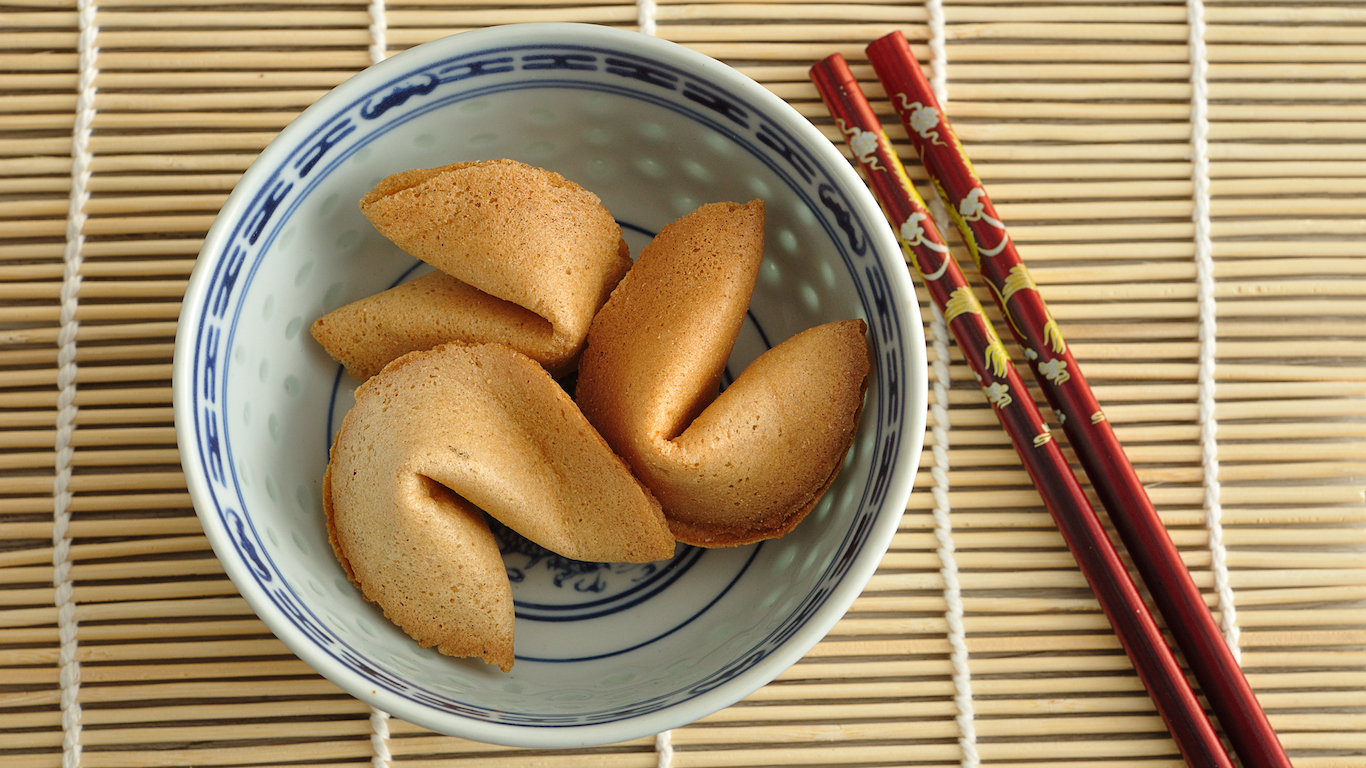
Cuisines all over the world adapt foods and techniques from other cultures. One of the most typical dishes of Japanese cooking, for instance, is tempura. But the Japanese learned how to deep-fry foods in batter from Portuguese merchants and missionaries who came to Nagasaki in the 16th century. “Tempura” derives either from tempero, Portuguese for “seasoning,” or from Quatuor Tempora, the Latin name for Ember days, on which Christians are supposed to eat fish and vegetables instead of meat.
The rich French stew called ragout was transformed in the Italian kitchen into a more finely textured pasta sauce, ragù.
In America, the great melting pot, our cooking pots are full of borrowings. Mexican specialties took on a new identity when they got to Texas; Chinese-American chefs in the 19th-century took inspiration from their homeland to fashion dishes appropriate to their new home. Ours is a cuisine of adaptation, open to the world.
Over the years, in this country, we’ve come to identify some of our favorite foods as Mexican or Chinese — or Cuban or German or Swiss — though they might be nothing of the kind. Perhaps they are indeed just regionalized variations on authentic originals. Other times, though, their names — even the geographical ones — aren’t what they seem at all. That doesn’t make the dishes they apply to any less delicious.
Click here to see 20 “foreign” foods that are really American
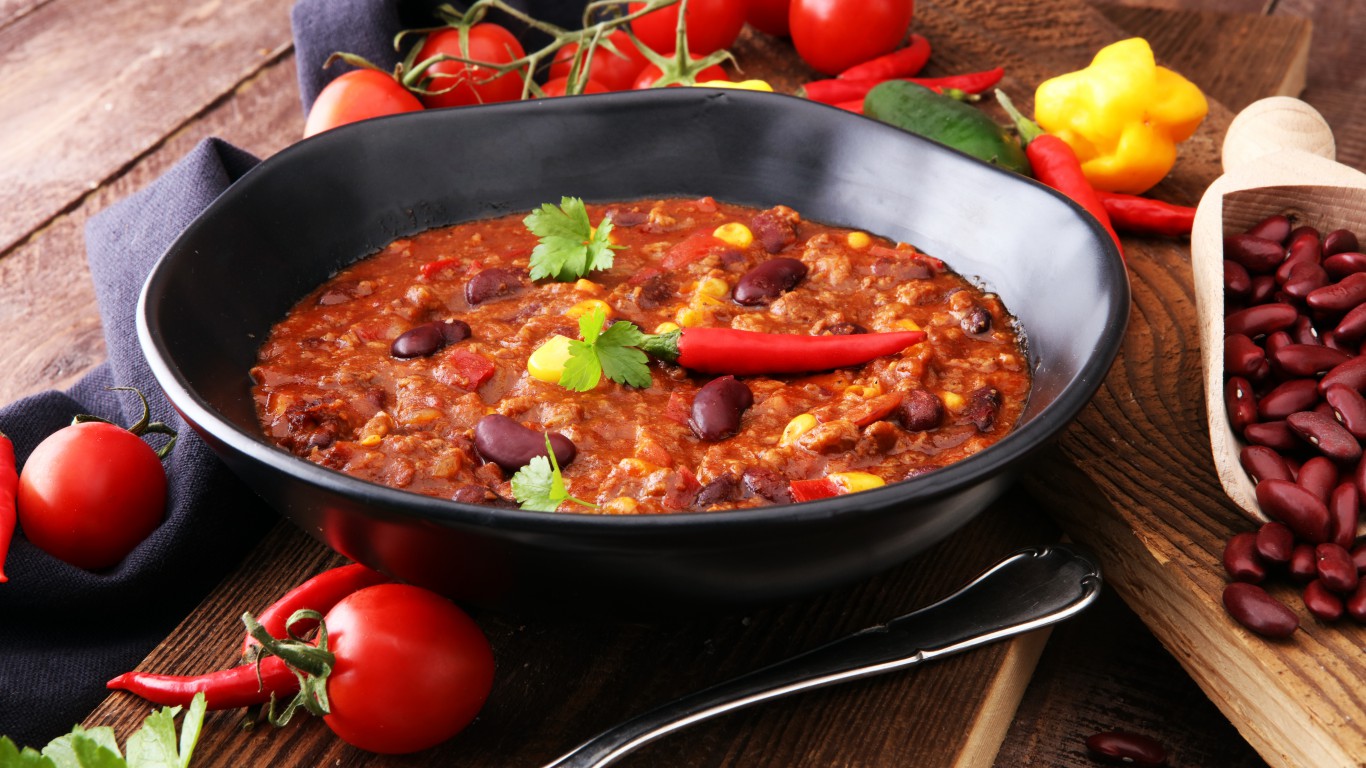
Chili con carne
Many Mexican dishes combine chiles with meat, which is literally what “chili con carne” means. Chili as we know it, though, comes from our side of the border, in southern Texas. It may have been concocted first by trail cooks on cattle drives. Another theory is that it was devised in the state’s prison kitchens as a cheap, filling way to feed prisoners. San Antonio became known as the chili capital thanks to the so-called “Chili Queens,” Mexican women who sold it and other dishes in the city’s plazas. Chili came to national attention in 1893, when Texas set up a San Antonio Chili Stand at the World’s Columbian Exposition in Chicago that year — and the rest is spicy history.
[in-text-ad]
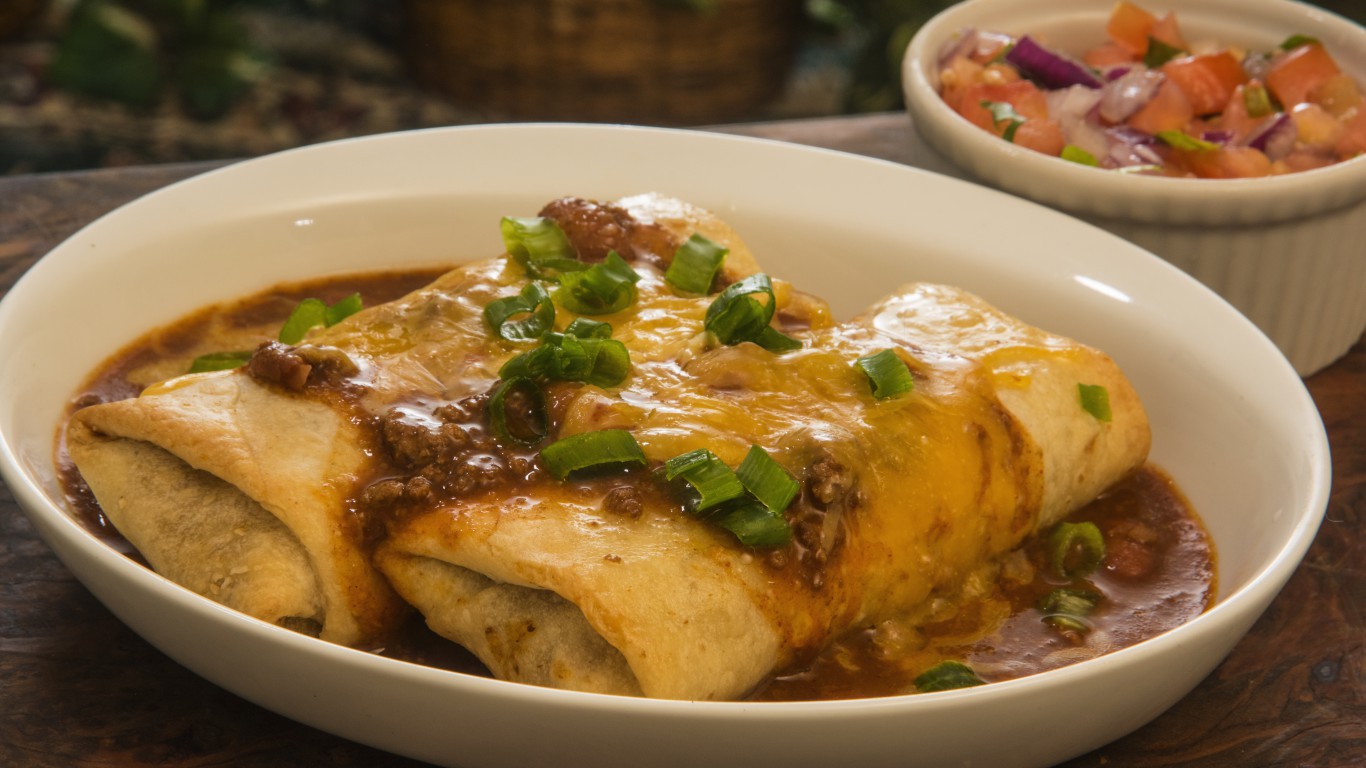
Chimichanga
This deep-fried burrito, particularly popular in the Southwest — and with the Marvel Comics character Deadpool — was most likely first made in Tucson, Arizona. The owners of El Charro Café, the city’s oldest Mexican restaurant, claim it was invented there in 1922, when founder Monica Flin accidentally dropped a burrito into a vat of bubbling fat. Another Arizona restaurateur, Woody Johnson, claims that he invented the chimichanga in Phoenix, but not till 1946.
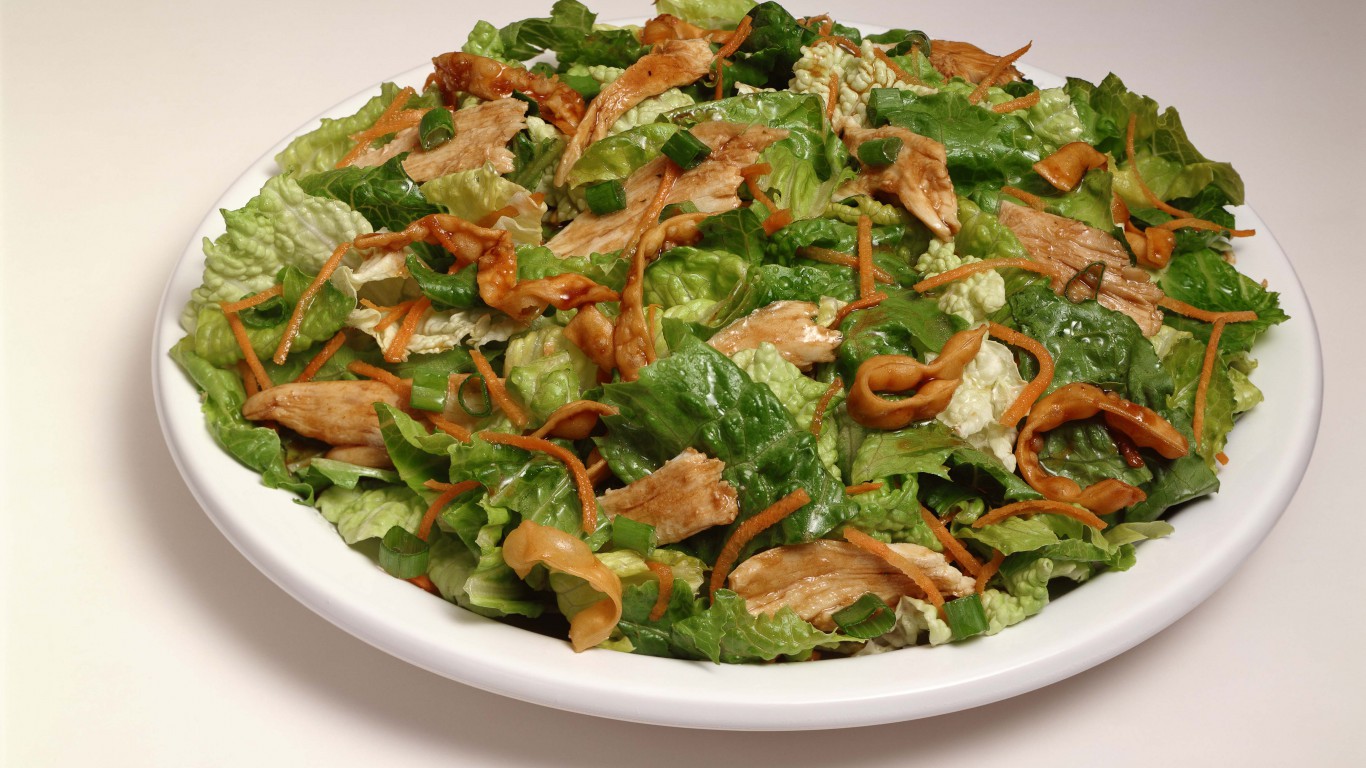
Chinese chicken salad
There are dishes made with shredded cold chicken in traditional Chinese cuisine,. But the Chinese chicken salad as we know it — chicken tossed with shredded cabbage or lettuce, fried wonton strips or rice vermicelli, and other ingredients, usually in a sesame or peanut dressing — first appeared in California in the 1960s. Credit is usually given to Sylvia Cheng Wu, who served the salad at her popular Madame Wu restaurant in Santa Monica.
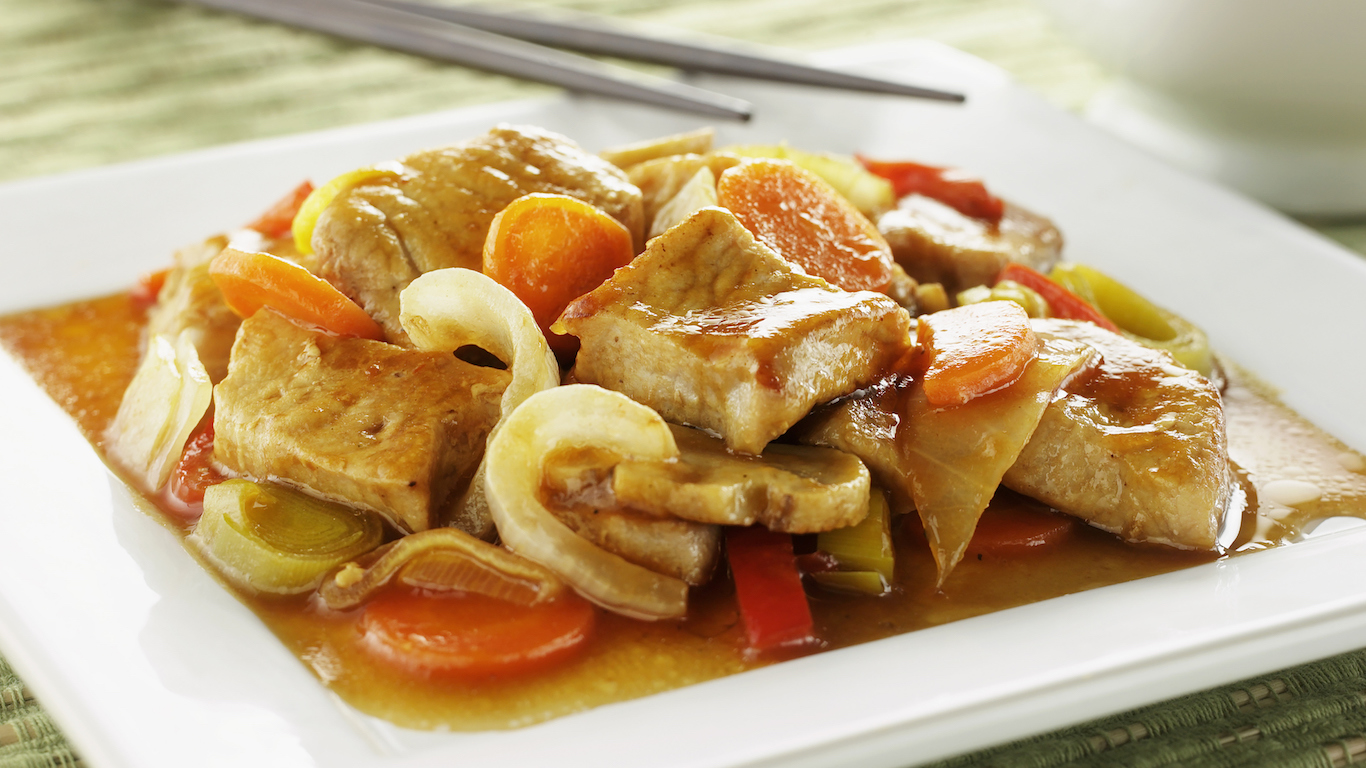
Chop suey
This expatriate Chinese restaurant staple is related to a regional Cantonese dish called tsap seui, or shap suì (“miscellaneous pieces” or “mixed bits”), which was usually made with minced organ meats. The version known in America, however — a stir-fried hash of meat or chicken with bean sprouts, celery, and other vegetables — was probably created as a cheap way of feeding miners or railroad workers by 19th-century Chinese-American cooks, possibly in San Francisco.
[in-text-ad-2]
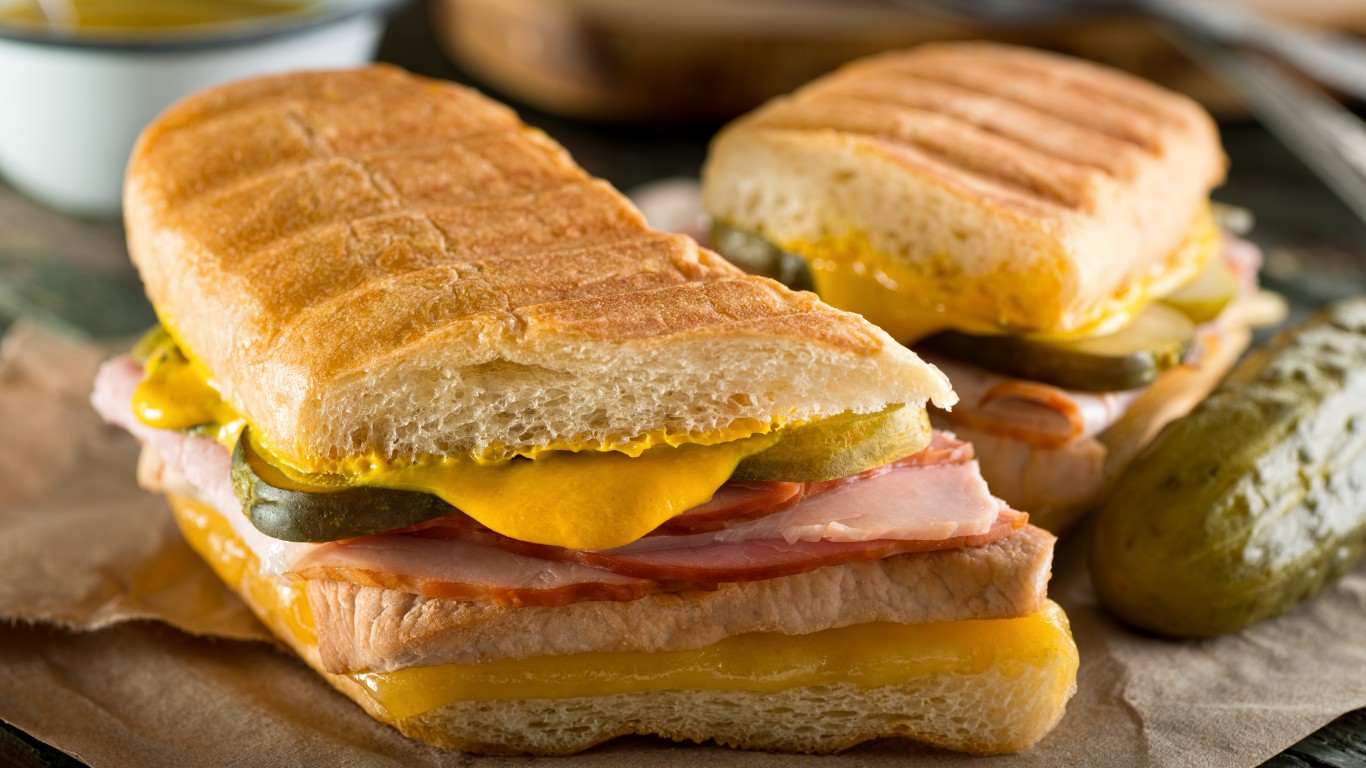
Cuban sandwich
Mixed meat sandwiches, or mixtos, were common workers’ fare in 19th- and early 20th-century Cuba. The modern-day Cuban sandwich, though, was first formulated by immigrant cigar makers in Key West, Florida, in the late 19th century and later refined in Tampa. The recipe traditionally includes roast pork, ham, Swiss cheese, and pickles on mustard-slathered lengths of Cuban bread — a baguette-like loaf with a thin, crisp crust. In Tampa, where a large part of the population is of Italian origin, salami is typically added to what has officially been dubbed “the signature sandwich of the city.”
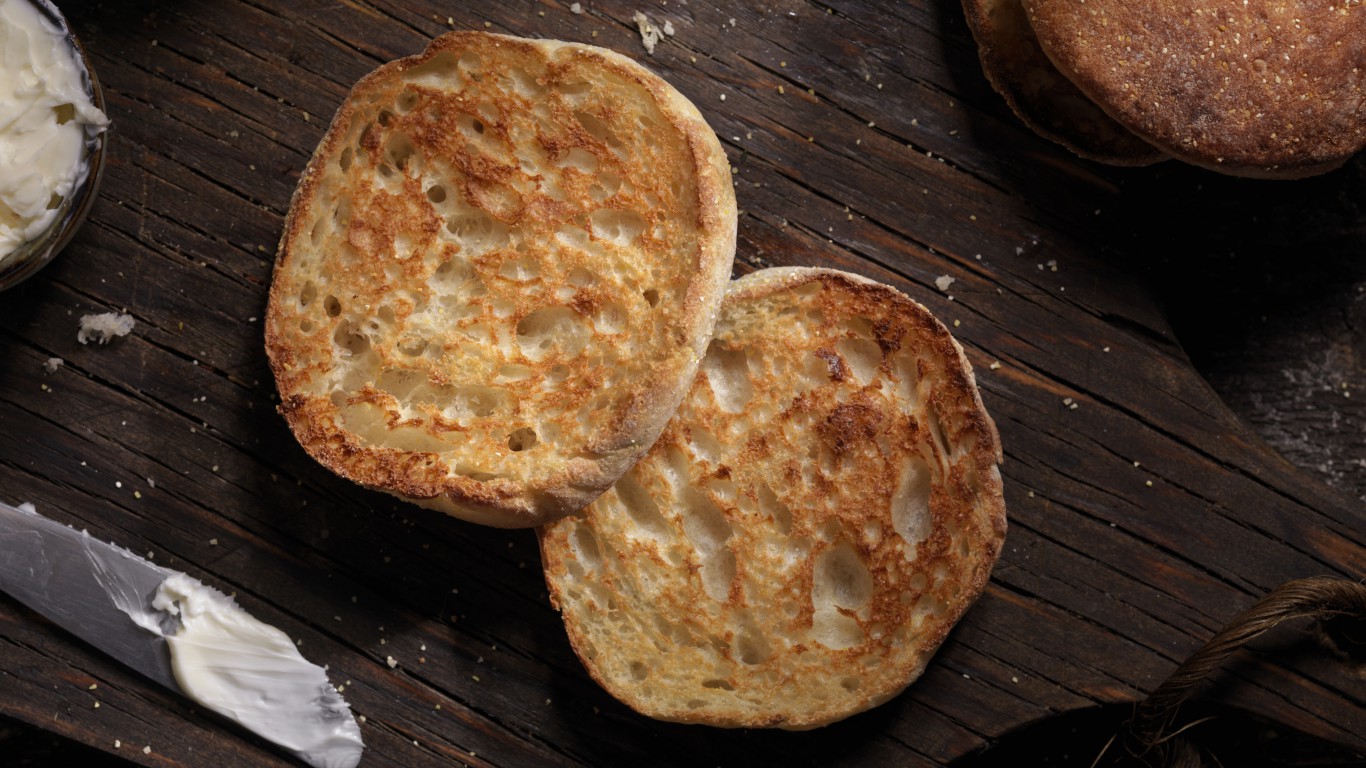
English muffin
The crumpet, a leavened griddle cake with a spongy texture and a porous top, has been popular in the U.K. since the 19th century. In 1880, an English immigrant to the U.S., Samuel Bath Thomas, opened a bakery in New York City, where he invented a variation he called “toaster crumpets.” Unlike their predecessors, which were eaten whole, these were cut into two halves so they could be toasted in a toaster or under a broiler. They eventually became known as English muffins, to distinguish them from cake-like regular muffins. Thomas’s company, now owned by a subsidiary of Mexico’s Grupo Bimbo, remains by far the largest purveyor of English muffins in the country.
[in-text-ad]
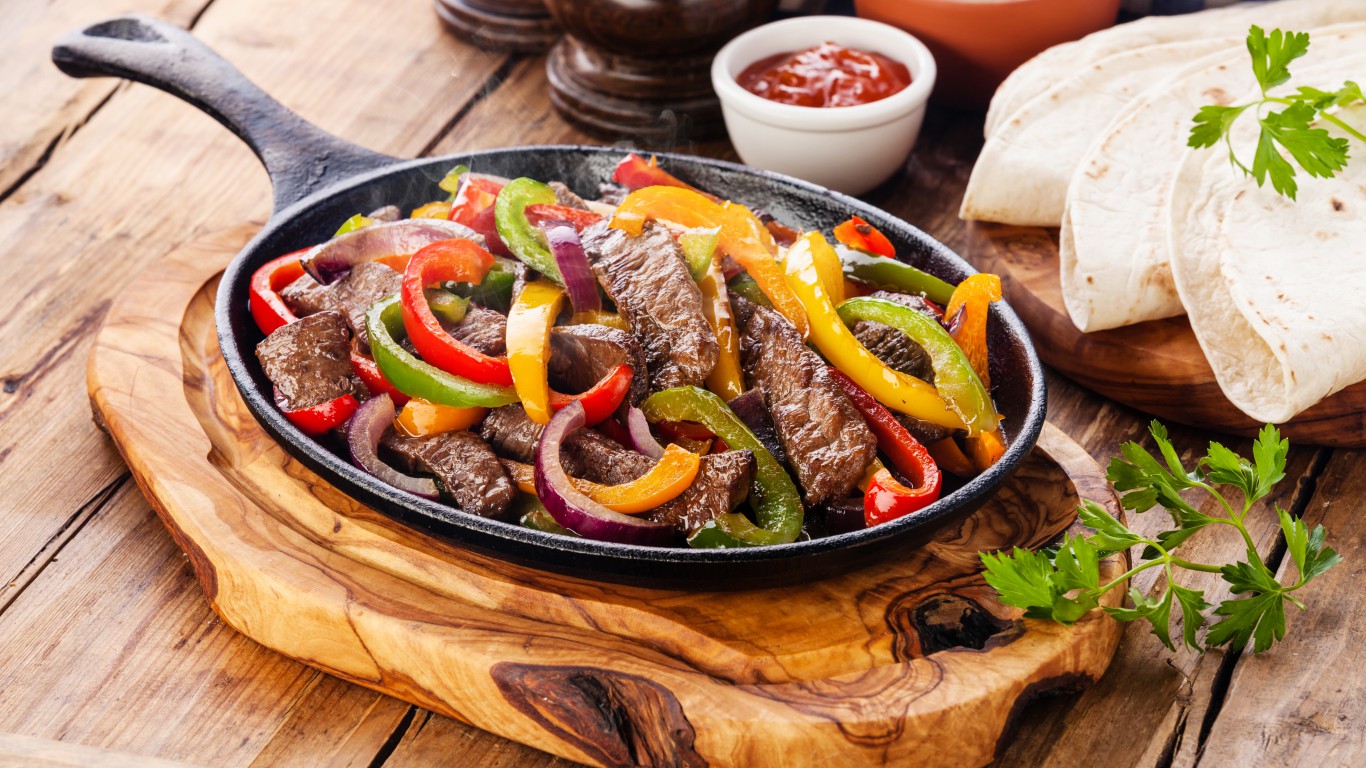
Fajitas
“Faja” is Spanish for strip or sash, and fajitas are a dish of little strips of meat (originally skirt steak), fried with bell peppers and onions and served with flour tortillas. Fajitas were originally trail food cooked up by Texas chuckwagon chefs on cattle drives. Modern versions, which gained popularity only in the latter part of the 20th century, are made not only with beef but with chicken, pork, shrimp, and other proteins, and are usually served sizzling on a hot metal platter.
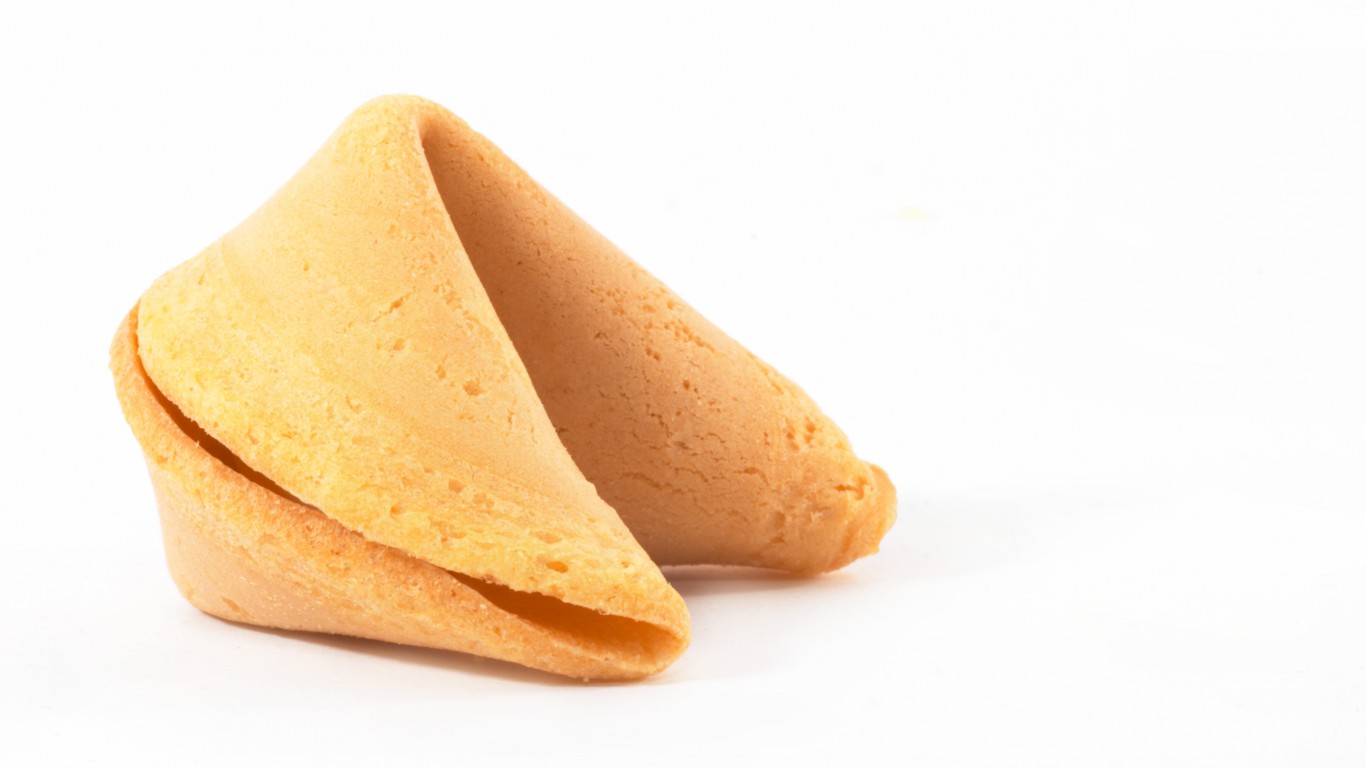
Fortune cookie
Strangely enough, this American Chinese restaurant cliché may have been invented by Japanese restaurateurs, though in Los Angeles or San Francisco. A confection similar to the fortune cookies we’re familiar with, flavored with sesame seeds, was first made in the southern Japanese capital of Kyoto in the 19th century. These were folded around slips of paper called o-mikuji, which contain short blessings (or curses!) and financial or personal predictions. They may have been introduced to America around the turn of the 19th century at San Francisco’s Japanese Tea Garden. A Japanese restaurant owner in L.A. and the Chinese founder of the city’s Hong Kong Noodle Company also claim to have brought the idea here but slightly later. When Japanese-Americans were interned and lost their businesses during World War II, Chinese bakers took over the industry in earnest, tweaking the recipe. After a Chinese-American graduate of the University of California named Shuck Yee invented a machine to fold them automatically in 1973, the cookies’ fortunes were assured.
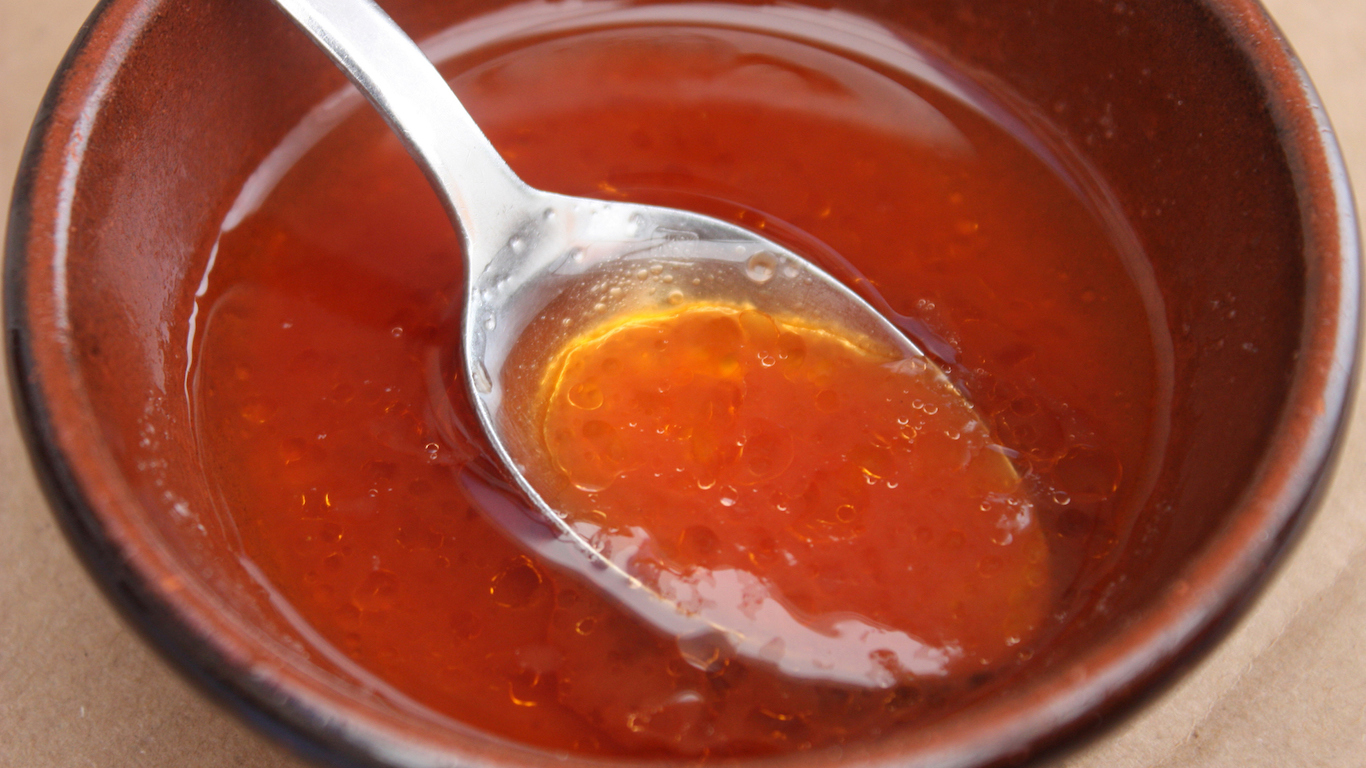
French dressing
The French almost always dress their salads with vinaigrette — an emulsion of olive oil and wine vinegar, with Dijon mustard, salt, and sometimes shallots, garlic, and sometimes various herbs mixed in. The sweetish, creamy, orange condiment sold as French dressing in the U.S. has an oil-and-vinegar base but adds tomato paste and/or ketchup, paprika, and brown sugar or corn syrup to the recipe. (There’s also a homemade version involving Campbell’s condensed tomato soup.) The original version may have been Milani 1890 French Dressing, made by a company founded in 1938.
[in-text-ad-2]
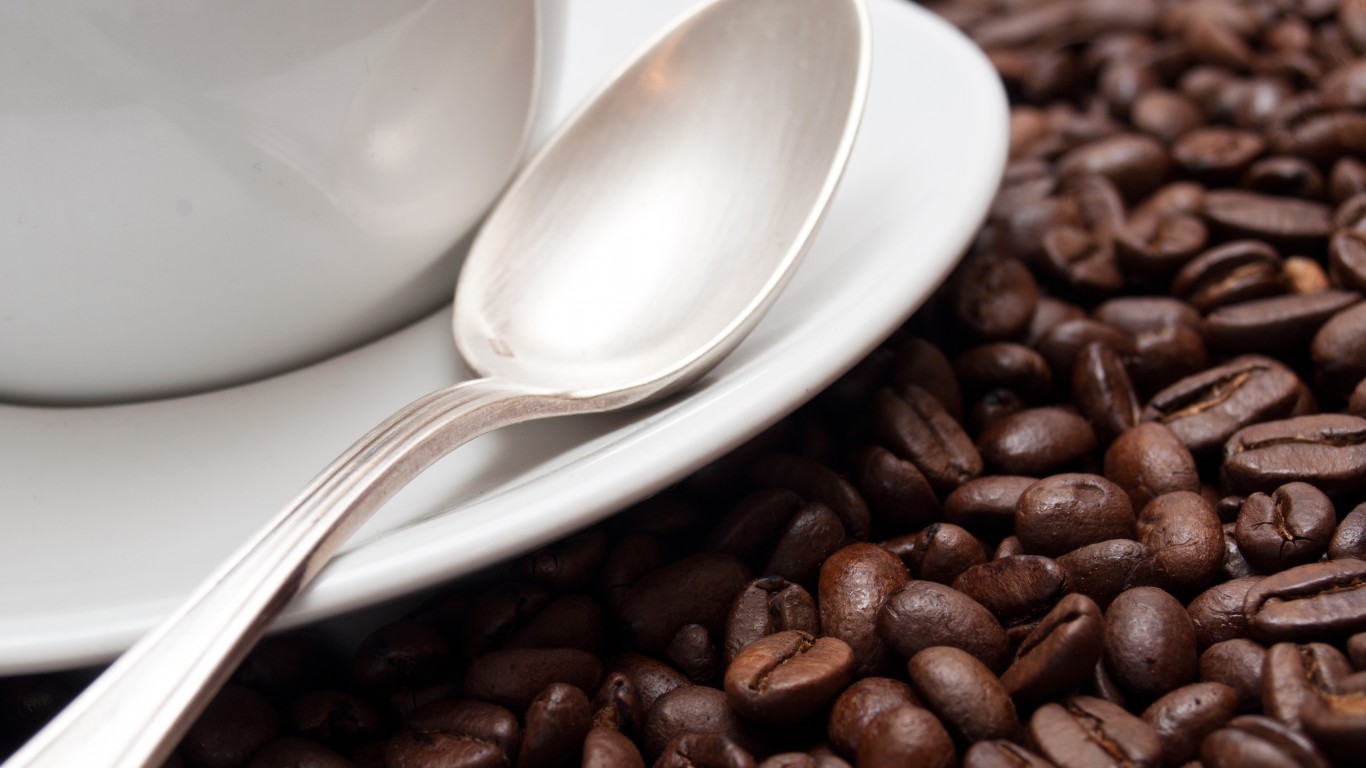
French roast coffee
In the years before the rise of specialty coffee shops in the U.S., American coffee drinkers traditionally preferred lighter roasts than European drinkers did. Dutch-American businessman Alfred Peet, founder of Peet’s Coffee & Tea in Berkeley, California, in 1966 was a pioneer in sourcing and roasting high-quality coffee beans in this country. With the European model in mind, he developed a dark roast with reduced acidity and a hint of burnt character, which he called “French roast” — apparently the first time the term was used. He might have as easily dubbed it “Spanish” or “Italian” or almost anything else European (though today Italian roast is even darker than French).
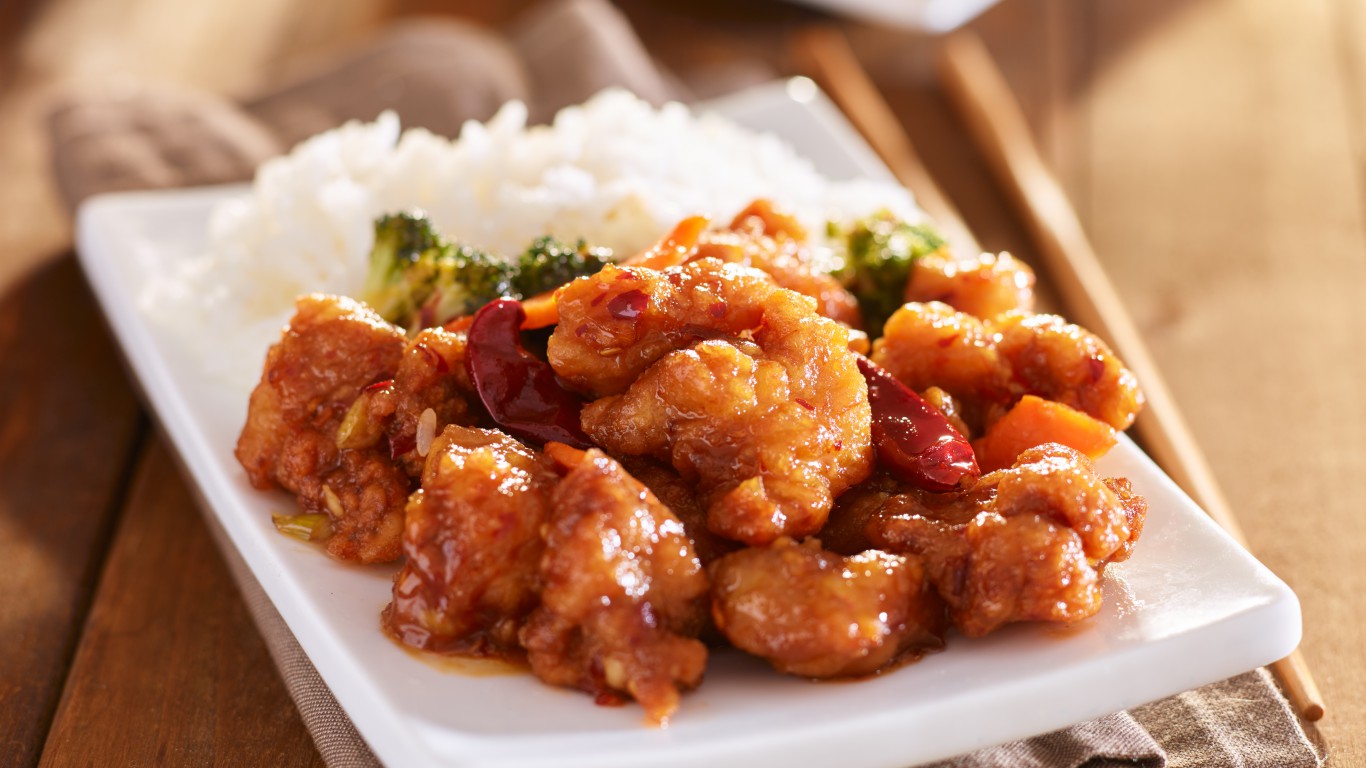
General Tso’s chicken
This Hunan-style preparation of chicken pieces fried in a cornstarch-based batter and cooked with chiles, ginger, garlic, soy sauce, rice vinegar, and other flavorings is probably named for Zuo Zongtang (or Tso Tsung-t’ang), a 19th-century Chinese military hero. He died long before the dish first appeared, however. An alternative theory suggests that the name comes not from a person but from the term zongtang, meaning “ancestral meeting hall.” In either case, one thing is certain: General Tso’s chicken is not a traditional Hunanese dish. A Hunan-born Taiwanese chef named Peng Chang-kuei claimed to have been the first to serve General Tso’s chicken at his restaurant in China in the 1990s, later importing it to his Peng’s Restaurant in Manhattan. However, the proprietors of New York City’s Shun Lee restaurants maintain that it was invented at their Shun Lee Palace, by their chef T. T. Wang in 1972.
[in-text-ad]
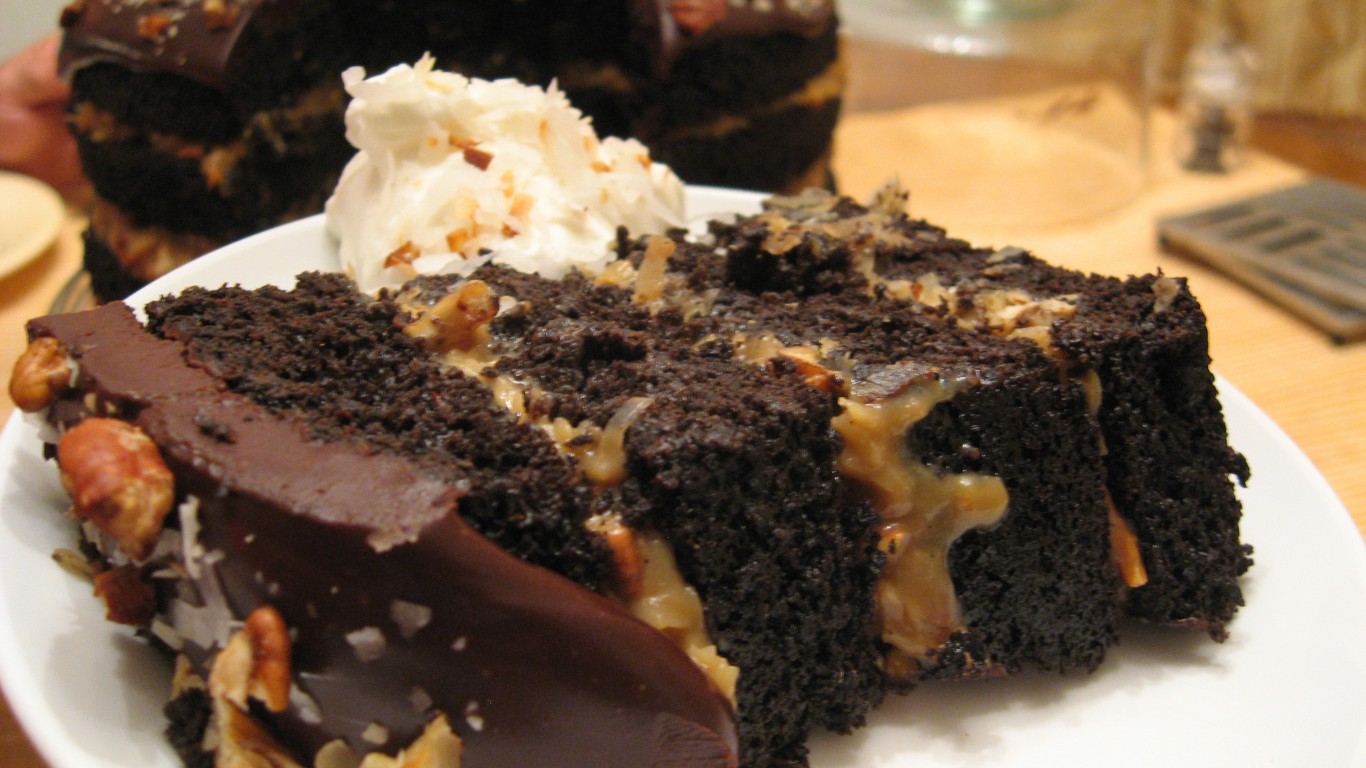
German chocolate cake
While the name German chocolate cake may evoke images of rich pastries at some Bavarian bakery or café, the fact is that this chocolate cake with coconut-pecan frosting owes its name not to a European country but to an English-born confectioner named Samuel German. In 1852, German developed a variety of baking chocolate for his employer, the Massachusetts-based Baker’s Chocolate Company, which sold it as Baker’s German’s Sweet Chocolate. In 1957, one Mrs. George Clay, a Dallas housewife, used the chocolate in a recipe she called “German’s Chocolate Cake,” published in the Dallas Morning News. General Foods, which then owned Baker’s, disseminated the recipe across the country, and at some point the possessive “s” disappeared, making the cake seem to be German.
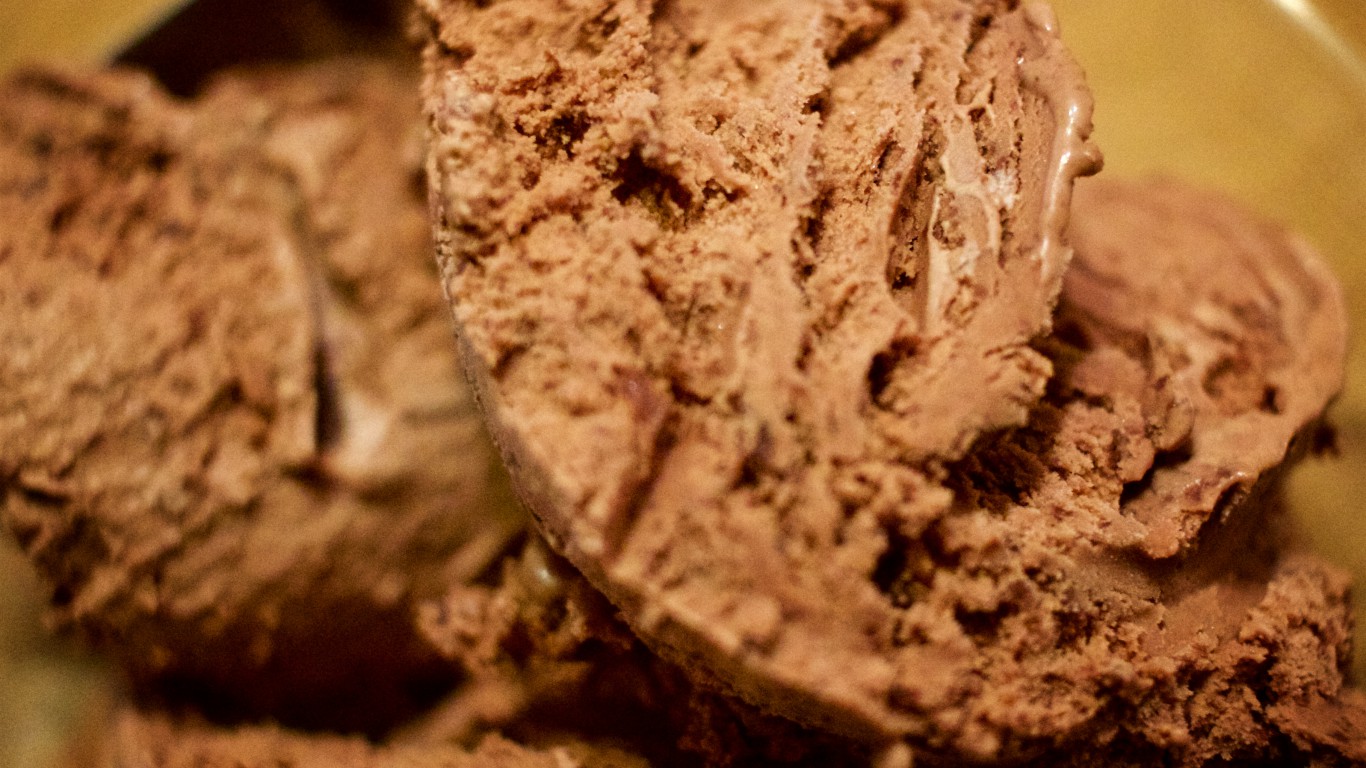
Häagen Dazs ice cream
In the 1920s, at the age of 10, Polish Jewish immigrant Reuben Mattus started helping an uncle who sold Italian ices in Brooklyn. He remained in the family business, becoming a purveyor of ice cream sandwiches and bars from a wagon in the Bronx. Years later, in 1960, as head of the company, Mattus decided to produce a line of premium ice creams, richer than the usual commercial brands. He wanted to give it a Danish-sounding name, perhaps because the Danes are famed for the quality of their dairy products and their love of ice cream, but also possibly as a tribute to the Danish Resistance heroes who saved most of their country’s Jews during World War II. Mattus’s daughter Doris later recalled that he sat in his kitchen for hours trying out nonsense words until he hit on “Häagen-Dazs.” Though the words mean nothing in Danish (which doesn’t use umlauts or have the “zs” letter combination), early cartons of the ice cream displayed a map of Denmark.
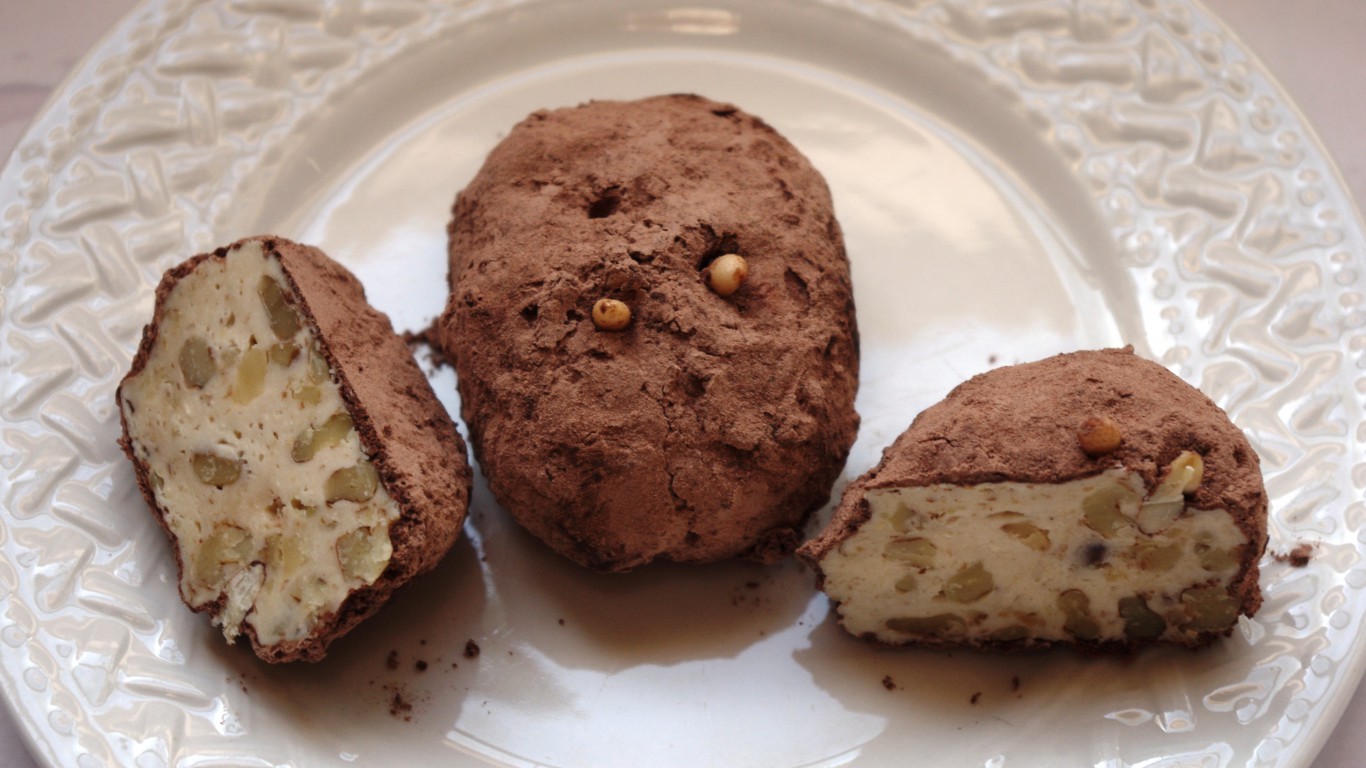
Irish potato candy
No potatoes were harmed in the manufacture of these sweet treats. These spud-shaped confections of dense coconut cream or white chocolate fudge are dusted with cinnamon and/or cocoa so that they resemble small potatoes just dug out of the ground. Pine nuts are sometimes embedded in the exterior to suggest potato eyes. Irish potato candies are a specialty of Philadelphia, dating back about a century. Who first created them isn’t recorded, but Oh Ryan, a candy maker in suburban Philly, claims to be their largest producer today.
[in-text-ad-2]
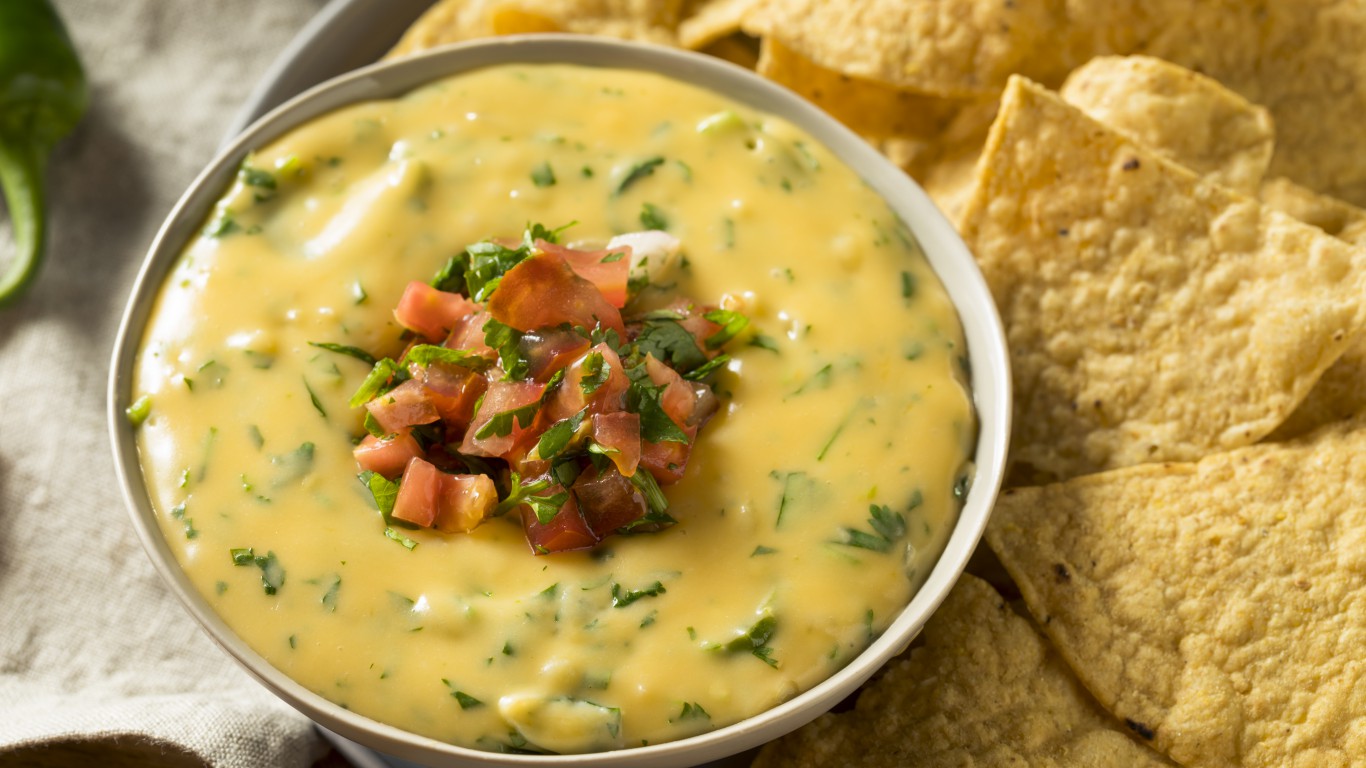
Queso
Also known as chile con queso (chile with cheese), this medium-thick and creamy Tex-Mex variation on fondue is related to dishes from northern Mexico called queso fundido (melted cheese) or queso flameado (“flamed” cheese). In the form it’s most often enjoyed in Texas and around the Southwest, though, it’s strictly a north-of-the-border invention. Some versions may use cheddar, Monterey Jack, or other conventional cheeses and add fresh chiles or various spices. But the classic version is nowhere near as fancy. It’s just a melted slab of Velveeta processed cheese, into which a small can of Ro-Tel Diced Tomatoes and Green Chilies has been stirred. Just add flour tortillas or corn tortilla chips to dip in the cheese.
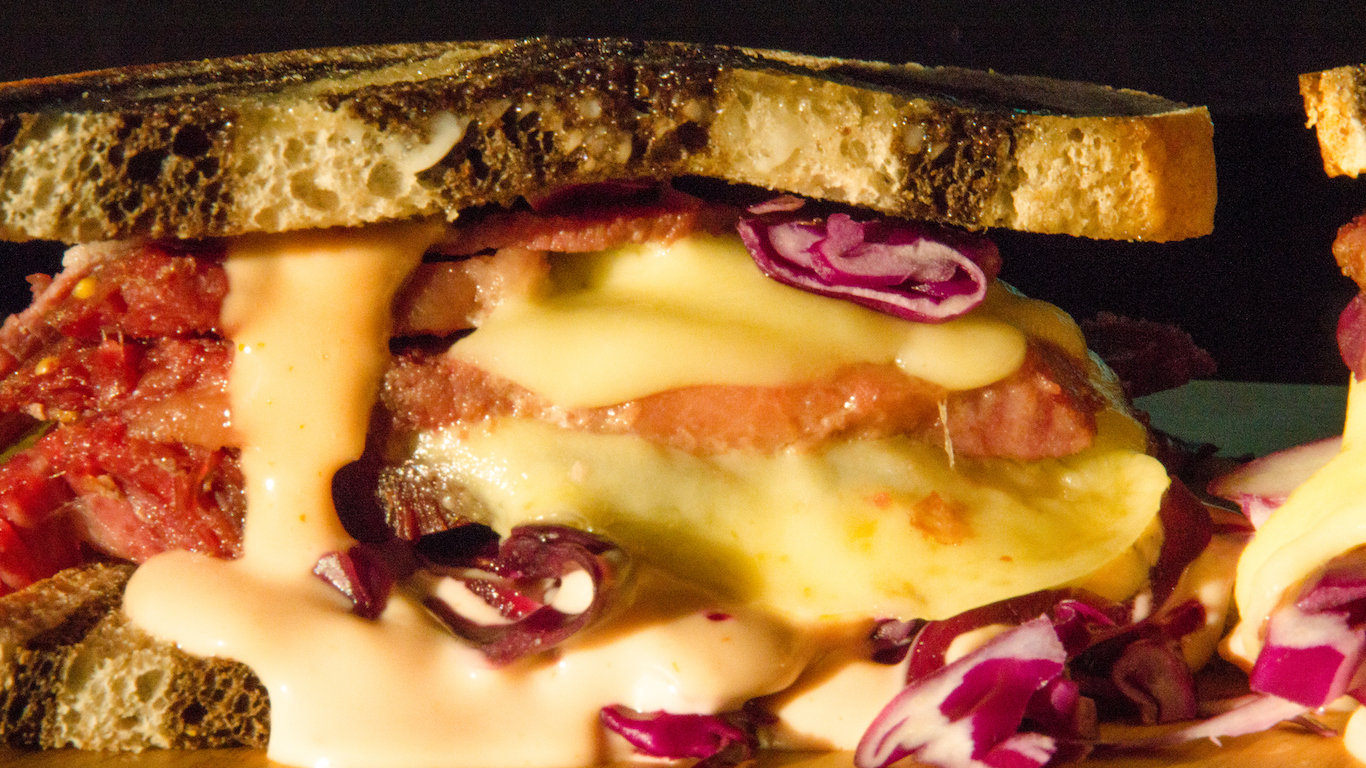
Russian dressing
A blend of mayonnaise and ketchup with added ingredients that may include horseradish, Worcestershire sauce, lemon juice, minced pimentos, chives, pickles or pickle relish, and hot sauce, this sandwich and salad dressing is unknown in Russian cuisine. One theory holds that it got its name because an early version included caviar. The term is recorded as early as 1900, but apparently initially it referred to a simpler vinaigrette. Credit for creating Russian dressing in the modern sense generally goes to New Hampshire entrepreneur James E. Coburn, who started selling it out of his Nashua store in 1910, and maybe earlier.
[in-text-ad]
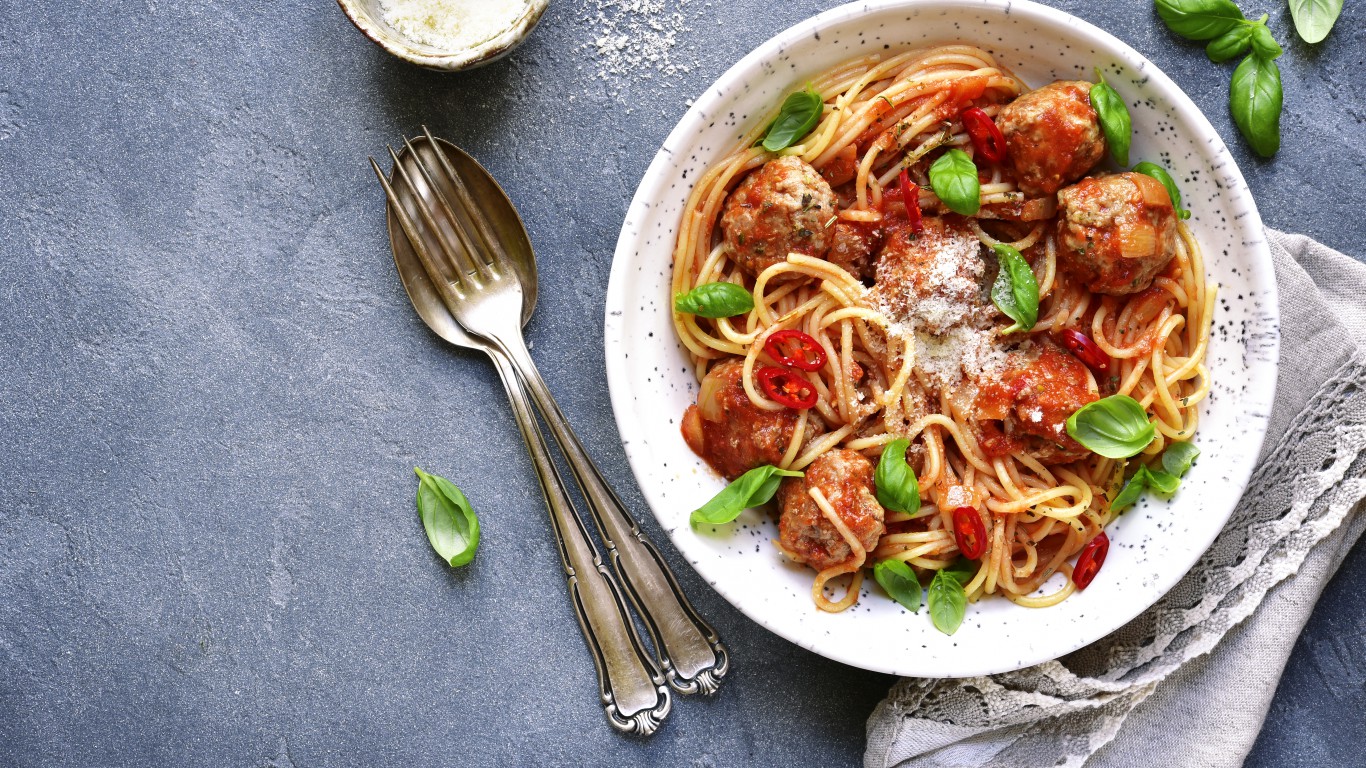
Spaghetti and meatballs
In Italy, meatballs are an appetizer, or even a main course. Adding them to spaghetti wouldn’t make much sense to an Italian cook: Main dishes and pasta are never served together in Italy, and, anyway, noodles are typically enhanced with fine- or medium-textured sauces that will cling to them, not large hunks of protein. The combination was almost certainly developed by Italian immigrants to New York City in the early 20th century. The Association National Pasta, founded in the U.S. in 1904, published what is apparently the earliest recipe for spaghetti and meatballs in the 1920s.

Spicy tuna roll
One of the most popular offerings at this country’s sushi bars, the spicy tuna roll is a nori seaweed-wrapped composition of tuna (often “scrape,” the bits left behind on the fish’s bones after the prime portions are removed), rice, spicy mayonnaise, and usually scallions and sesame seeds. Spicy foods are rare in traditional Japanese cuisine, but American customers at sushi bars would often ask for them. Some sources report that this particular answer to their request was first made at one sushi bar or another in L.A.’s Little Tokyo. But Jean Nakayama of the 104-year-old Maneki in Seattle claims that her husband, Kozo, invented it there in 1984.
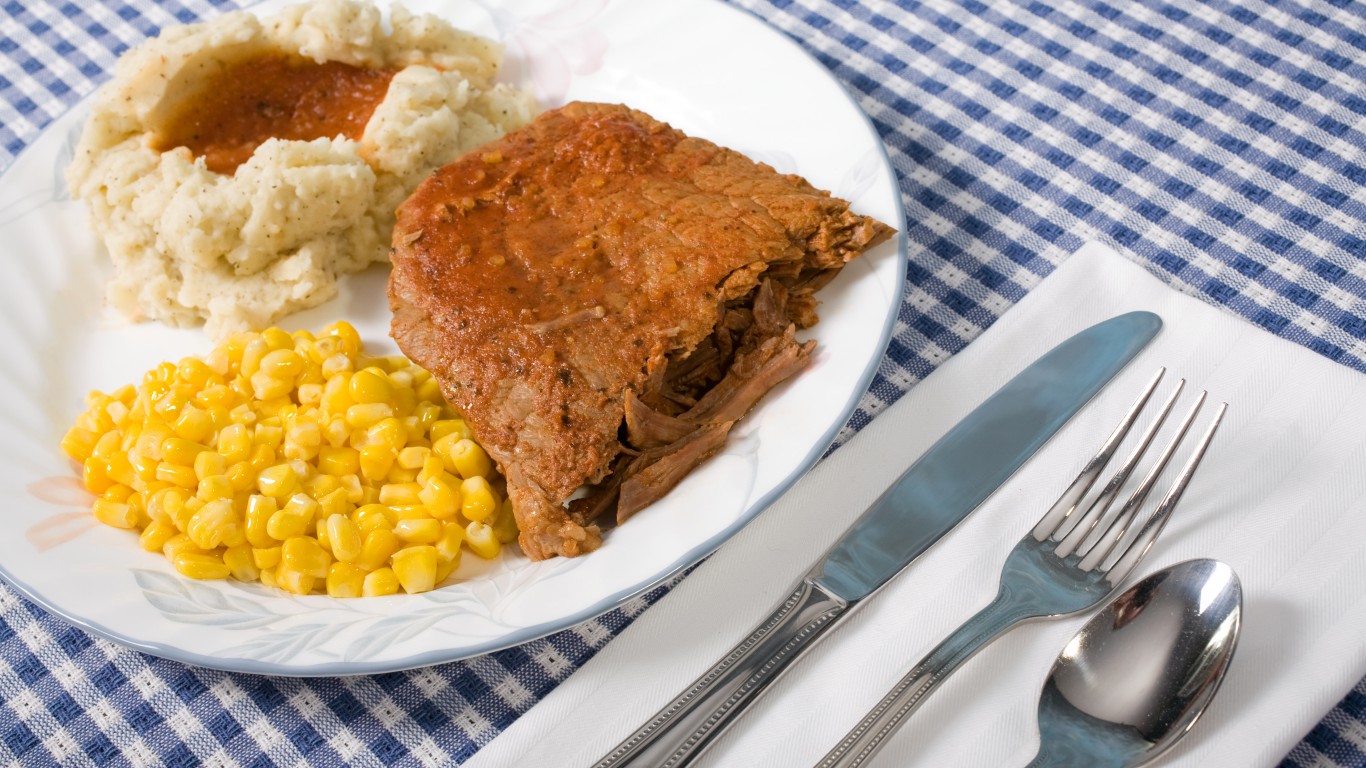
Swiss steak
An inexpensive cut of beef or other red meat, tenderized by pounding or rolling, then braised in a sauce, Swiss steak has nothing to do with Switzerland. Food historian Charles Perry once reported in the Los Angeles Times that the term started appearing in American cookbooks in the 1920s, though he mentions that a similar dish, a tough cut of meat braised in tomato sauce, dates from 1859. Perry opines that Swiss steak probably got its name from “some Jazz Age newspaper food writer […] for no better reason than the Swiss reputation for thrift and frugality.” A more commonly accepted derivation is that it’s a reference to swissing, the process of smoothing and compressing of cloth or paper through rollers.
[in-text-ad-2]
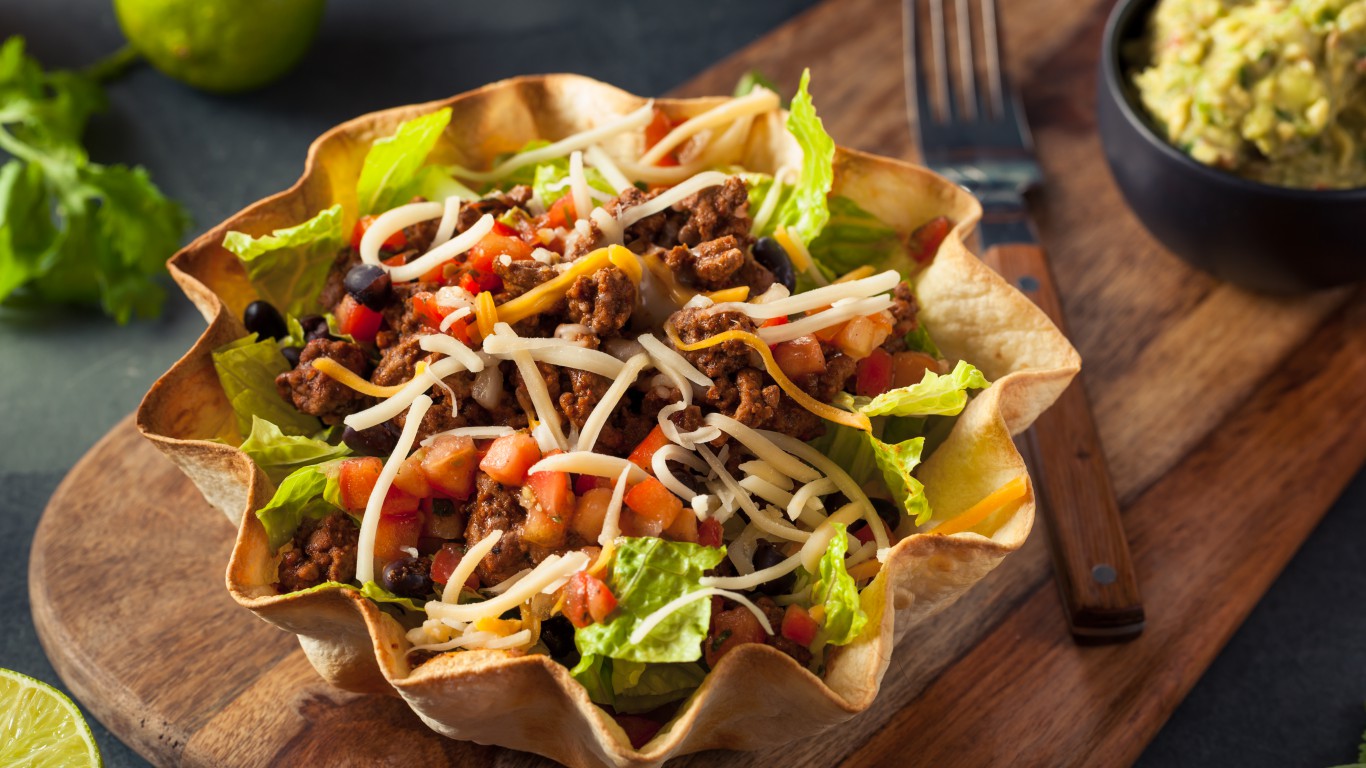
Taco salad
There’s no such thing as taco salad in Mexico, birthplace of the taco. Consisting of a large fried flour tortilla shaped into a kind of fluted bowl and filled with the typical ingredients in an American fast-food taco (chicken or ground beef, shredded lettuce, shredded cheese, etc.), the dish has its origins in, of all places, Disneyland. Charles Elmer Doolin, a candy store manager from San Antonio, Texas, who “invented” Fritos — he actually bought the recipe from a Mexican immigrant. Doolin came up with something called the Tacup in the 1950s. This was a taco shell shaped like a fluted pastry shell, into which he heaped a filling. When the Frito company opened a sort-of Mexican restaurant called Casa de Fritos in Disneyland in 1955, the Tacup was on the menu. It proved popular, and soon other restaurants were making their own versions, larger and based on flour rather than corn tortillas.
In 20 Years, I Haven’t Seen A Cash Back Card This Good
After two decades of reviewing financial products I haven’t seen anything like this. Credit card companies are at war, handing out free rewards and benefits to win the best customers.
A good cash back card can be worth thousands of dollars a year in free money, not to mention other perks like travel, insurance, and access to fancy lounges.
Our top pick today pays up to 5% cash back, a $200 bonus on top, and $0 annual fee. Click here to apply before they stop offering rewards this generous.
Flywheel Publishing has partnered with CardRatings for our coverage of credit card products. Flywheel Publishing and CardRatings may receive a commission from card issuers.
Thank you for reading! Have some feedback for us?
Contact the 24/7 Wall St. editorial team.
 24/7 Wall St.
24/7 Wall St. 24/7 Wall St.
24/7 Wall St.



